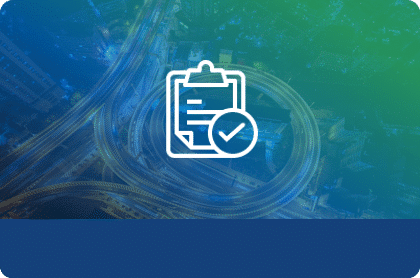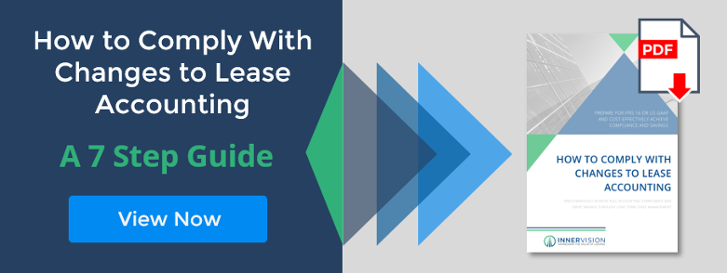IFRS 16 & ASC 842 Lease Accounting Check List
Updated 17th September 2024 | 13 min read Published 9th April 2019

2019 is the first accounting period for which the new lease accounting standards must be applied – do not let things drift but instead satisfy yourself that the following areas have been understood and addressed.
This post covers the fundamentals of the new standards and provides a synopsis of the main changes, explores the impact on financial metrics and outlines a lease accounting checklist detailing what you may want to consider when adopting the new standards.
Do you and your staff know “What has changed”?
By now, you should hopefully have a solid understanding of the main changes. But to refresh your knowledge here’s a quick recap:
- The new leasing standard removes the distinction between finance and operating leases for lessees.
- Enhanced guidance is introduced on identifying whether a contract contains a lease.
- Guidance also now demands that any service element is stripped from a lease contract.
- A completely new lease accounting model for lessees now requires lessees to recognise all leases on balance sheet, except for short term leases and leases of low-value assets is introduced.
- Lease accounting treatment now constitutes the “right of use” of an asset and the corresponding financial commitments associated with that “right of use”. Both are recognised on the balance sheet at present value of future rentals.
- Rent expense on the P&L is now replaced with depreciation charge and interest expense – depending on the lease portfolio size, profit will be impacted.
- Leased assets and interest on the liabilities will be amortized over the lease term.
- On the cash flow statement, the payments will be separated into a principal portion (presented within finance activities) and an interest element (presented either within finance or operating activities).
How will IFRS 16 impact your balance sheet and financial metrics?
For those with substantial off-balance sheet items the expected implications on financial statements and metrics include:
- The assets and liabilities on balance sheets will increase significantly, with a potentially material impact on covenant calculations. Most sophisticated users of financial statements (including credit rating agencies and lenders) already estimate the effect of off-balance sheet leases on financial leverage, particularly when a company has a significant amount of off-balance sheet leases. Banks set interest rates based in part on credit ratings when credit ratings are available. Because the credit rating agencies adjust for off balance sheet leases, the interest rates charged on loans granted to rated borrowers are not expected to change as a result of the implementation of the new standards.
- The cost profile of income statements will change, with costs skewed towards the early years of leases and greater volatility due to the frequency of recalculation assets and liabilities are altered over the lease term
- The nature of costs in the income statements will change, with a positive impact on EBITDA, but a greater weighting to finance costs and depreciation, again potentially impacting calculations of covenants. Depending on the wording of finance documents, this could also have an impact on cash sweeps, management bonuses etc.
- The accounting benefits of sale and leaseback transactions could be negatively impacted.
- Companies should consider whether they need to renegotiate any loan or other agreements due to changes in their financial metrics:
- Current Ratio will decrease as current lease liabilities increase.
- Debt to Equity Ratio will increase as lease liabilities will increase total liabilities on a balance sheet thereby increasing the reported debt load.
- Asset Turnover (sales to total assets) will decrease as reported assets on the balance sheet increase but sales, of course, are unchanged.
Preparing for IFRS 16 – areas of focus:
Data:
The success of any lease accounting implementation is often dependent upon the quality and completeness of the lease data. For many organisations, the data collation stage is the most challenging due to the availability of critical lease data. When undertaking this phase of your lease accounting project it is worth considering the following:
- Data collation:
- Where are you in the data collation exercise?
- Have you identified the key data capture points required for lease accounting compliance?
- Data integrity/quality:
- Has all appropriate lease data been fully captured?
- Are all the assets and locations subject to “right of use” known, subject to current leases, in use, locatable and accounted for?
- Is the newly centralised data accurately recorded and readily available to interested parties?
- Data consistency – Has a new process to maintain lease data been put in place?
- Accounting Alignment – Is lease data aligned with the organisation’s accounting policies?
- 3rd party assistance – Will 3rd party organisations be involved in gathering and maintaining the data?
Systems:
To simplify the transition to the new standard most companies will require new lease accounting software to help report, automate and track all leasing data under IFRS 16 and ASC 842. When implementing such software companies should focus on:
- Early Identification and evaluation of system requirements – Has a lease accounting vendor been selected?
- Testing – Has your organisation’s lease accounting system been end-to-end tested?
- Communication – Have all the relevant holders of lease data been engaged?
- Auditor engagement – Have your auditors been invited to test your lease system and its processes?
- System validation and performance – Is the solution proven (how many implementations are they actively managing)?
- Users activation – Have you allocated the users and super users within your company and have they been set up and configured in the system?
- Security – Has the solution fulfilled all information security and risk requirements?
- Support – What level of support will you receive from vendors?
- General ledger:
- Have you determined how the system will interface with your relevant general ledger applications?
- Have all the general ledger codes been configured in the system?
- System configuration
- Has your lease accounting software been configured to accurately reflect your corporate structure?
- Does the system reflect your required reporting hierarchy?
- Have defining user roles been set up in the system?
- Reporting
- Is there a requirement for IAS 17 comparative reporting?
- How do you need the system configured to provide useful reports and reflect your business?
- Accounting requirement – Do you have multiple charts of accounts or require new accounts set up in your existing ERP(s)?
Operational and internal controls:
Accounting teams required a well throughout and defined strategy for transitioning to the new standards. Organisations may need to deploy new internal systems, policies and controls for managing the process. Below are some considerations:
- Are controls and documentation in place around manual processes for interim lease accounting solutions?
- Have the positive effects of transitioning data to the cloud been explored and considered?
- Auditor engagement – Do you have alignment with your auditors with regard to the accounting treatment of transitioned as well as new leases?
- Have you developed an implementation timeline/schedule?
- Do you have a defined date for implementing the new standard?
- Review of IT systems.
- Training of finance teams and other relevant departments.
- Review of the completeness and accuracy of the contract data.
- Review control procedures and lease approval processes.
- Internal controls over lease processes and accounting.
Accounting decisions:
There are certain accounting policy elections and practical expedients available under the new standards. Accounting teams will need to make calculated decisions when deciding how these should be applied. It is advised that organisations solicit guidance from external auditors when evaluating these decisions. Key accounting and policy considerations include:
- Accounting policies:
- Have you aligned and updated your accounting policies to reflect the new definition of a lease, short term and low-value assets exemptions, determine lease terms, the implicate rates and lease classification etc?
- Have you fully explored and reviewed the different policy options and elections available under the new standard?
- Transition approach – Have you decided on which transition method to apply?
- Lessees may choose either a full or a modified retrospective transition approach.
- Under the modified approach certain transition relief is available.
- Impact assessment – Have you evaluated and assessed the accounting implications and conducted a thorough impact assessment?
- Lease classification – Have you identified all contracts for reclassification under the new standard.
- Practical expedients – Contracts with multiple components:
- Have you identified all contracts with both lease and non-lease components?
- Have you determined whether to apply the practical expedients for separating these components?
- Application of exemptions – Have you determined whether to apply the low-value assets and short-term leases exemption?
- Judgments:
- Have you determined how the various judgments will be considered/managed?
- Have you documented the key judgments applied?
- Auditor engagement – Have you reviewed transition options, accounting policy elections and practical expedients with external auditors?
- Project lead
- Who is going to be running the project in your organisation?
- Will it be centrally managed or devolved to local offices?
Standards:
You also need to make sure you have the FASB/IASB leasing standards documented and visible for all affected parties. You need to be able to answer client questions about the changes, so it’s important to make sure your company is compliant with them and that they’re easily referenceable. Reading about the new FASB/IASB leasing standards won’t be enough. Have you talked with leasing consultants to ensure that you have a thorough briefing on the ins and outs of the new leasing standards? Your business, your bankers, your lessees and even your clients will depend on you to be knowledgeable about them and to be prepared for them when the standards take effect.
Resource readiness:
Adopting the new lease accounting standards will require a significant amount of resources, planning and cross-departmental cooperation to successfully implement. In many instances, the project will be driven by the accounting department, but the broader scope may also include legal, treasury, procurement, IT and property departments. In other instances, elements of application will be outsourced to 3rd party organisation and financial advisers. In any scenario, organisations must consider their resource readiness. Some considerations include:
- Internal resource:
- Has the organisation staffed enough well-trained, relevantly skilled professionals to manage and complete the implementation?
- Has the organisation determined the departments from which various professionals and experts will be required?
- Have the various aspects of lease accounting been delegated and are those who now own those aspects aware of them?
- Internal communication:
- Have role-specific communication lines and training plans been developed?
- Has a support structure been created for stakeholders across the organisation – particularly those who are subject to bonus schemes measured against KPI and ratios that may be adversely affected by the impact of the new standards?
- Training/Hiring:
- If necessary, has specific training been provided/developed?
- Will additional staffing requirements be needed to support the implementation? If so, has appropriate time been allocated to support the necessary recruitment drive?
- External resource:
- Have auditors been engaged to help manage the project and if so, how involved will they be?
- Are external consultants and vendors supporting the implementation project?
- How involved will lease accounting software vendors be in supporting your implementation procedure?
- Budget:
- Has an appropriate budget been identified/allocated?
- Will additional budgetary requirements be necessary?
Policies/Processes:
It is almost universally excepted by finance professionals that the impact of the new accounting standards will require companies to evaluate and transform many of their business and accounting policies. Areas organisations might want to consider include:
- Data – Are data processes and system work-streams documented, understood and aligned to accounting policies?
- Auditor alignment – Are you and your auditors at one around the new accounting policy, including management judgments?
- Stakeholder orientation – Have stakeholders been clearly communicated with about elections, options and exemptions to support alignment?
- Policy consistency – Is there a process for keeping the new processes and policies current with the latest guidance?
- IT requirement / Information security – Have new IT systems and robust processes be developed.
- System requirement – Has your corporate IT team put in place processes for implementing lease accounting software, plus on-going system monitoring and system security?
Internal / External stakeholders:
Due to the complexity of the new standards, it is unlikely that corporate stakeholders and investors will have the practical knowledge or comprehensive understanding of the full impact the standards will have on the organisation from a technical or accounting standpoint. Therefore, it’s critical that the project team charged with handling the transition have a clear plan for when and how to communicate the effects to corporate stakeholders. Consider the following:
- Impact on key performance indicators:
- Do investors, analysts and lenders understand the KPI and covenant impacts of the new lease accounting standards being applied in your organisation?
- Have they been made aware of why certain gearing ratios may have moved in the “wrong” direction?
- Are loan covenants in danger of being breached and therefore need reviewing, understanding and renegotiating.
- Accounting policy elections – Have stakeholders been informed about what policy elections and judgments will be applied to support alignment?
- Transition options – Have stakeholders been informed on important transition option decisions and associated implications?
- Software decision – Have software user groups been tapped to see how others are overcoming these challenges?
- Benefits of the new standards – Have both internal and external stakeholders been made aware of the opportunities that exist when applying the new standard such as enhanced processes, improved portfolio visibility, pro-active lease management and lease portfolio savings?
Leasing Post-Transition:
Although, undoubtedly the most important element of the compliance process, organisations should be aware that transitioning to IFRS 16 and ASC 842 is just part of the overall process. Once implemented, companies must also evaluate lease portfolio performance and ongoing lease management practices for maintaining existing and future leases post-transition. Examples of future lease management considerations include:
- Negotiations: It is time to start rethinking your lease negotiation tactics. The leasing standard changes and updates aren’t just going to affect the back-end of your operations; they’ll directly impact your lease negotiations as well for new transactions.
- Have you engaged with your lessors to review and improve the lease rates you are enjoying on existing leases as you tie them into new opportunities?
- Compare the competitiveness of your lessors – there may be a case for renegotiating some or all your extant leases to optimise the efficiency of your lease portfolio, consolidate leases and perhaps see reduced rentals via an improved interest rate.
- Will 3rd party organisation and consultants with proficiency in lease negotiation be required to critically review your portfolio and negotiate savings?
- Maintaining leases post-transition:
- Processes – Do you have a process for identifying new leases?
- Controls – Have you developed internal controls for managing and procuring new leases?
- Tracking – Have processes for tracking, managing and maintaining lease contracts post-transition been established?
- Modifications – Do you have a process for tracking changes to leases that might result in modifications?
- End-of-lease – Have controls and processes for end-of-lease notifications and renewals, terminations, and asset buyouts been implemented?
- 3rd party engagement – Will third-party organisation be used to help conduct the lease management post-transition?
- Portfolio evaluation – Have you audited the effectiveness of your portfolio – could they be returned, and the leases terminated or have the leases expired and run-on as a default?
Ultimately, the two biggest boxes you can tick on your FASB/IASB lease accounting checklist are firstly having at least committed to the changes and secondly one that will make all the other steps easier — is implementing a software solution such as LOIS Lease Accounting from Innervision. If you’re interested in seeing the tool in action, request a demo today.
Where can I find more guidance on transitioning to IFRS 16 and ASC 842?
For further guidance on implementing the new lease accounting standards, we have put together this inclusive guide to transitioning to the new standards – IFRS 16 or FASB ASC 842. Just follow the link below to access the guide.
Disclaimer: this article contains general information about the new lease accounting standards only and should NOT be viewed in any way as professional advice or service. The Publisher will not be responsible for any losses or damages of any kind incurred by the reader whether directly or indirectly arising from the use of the information found within this article.


